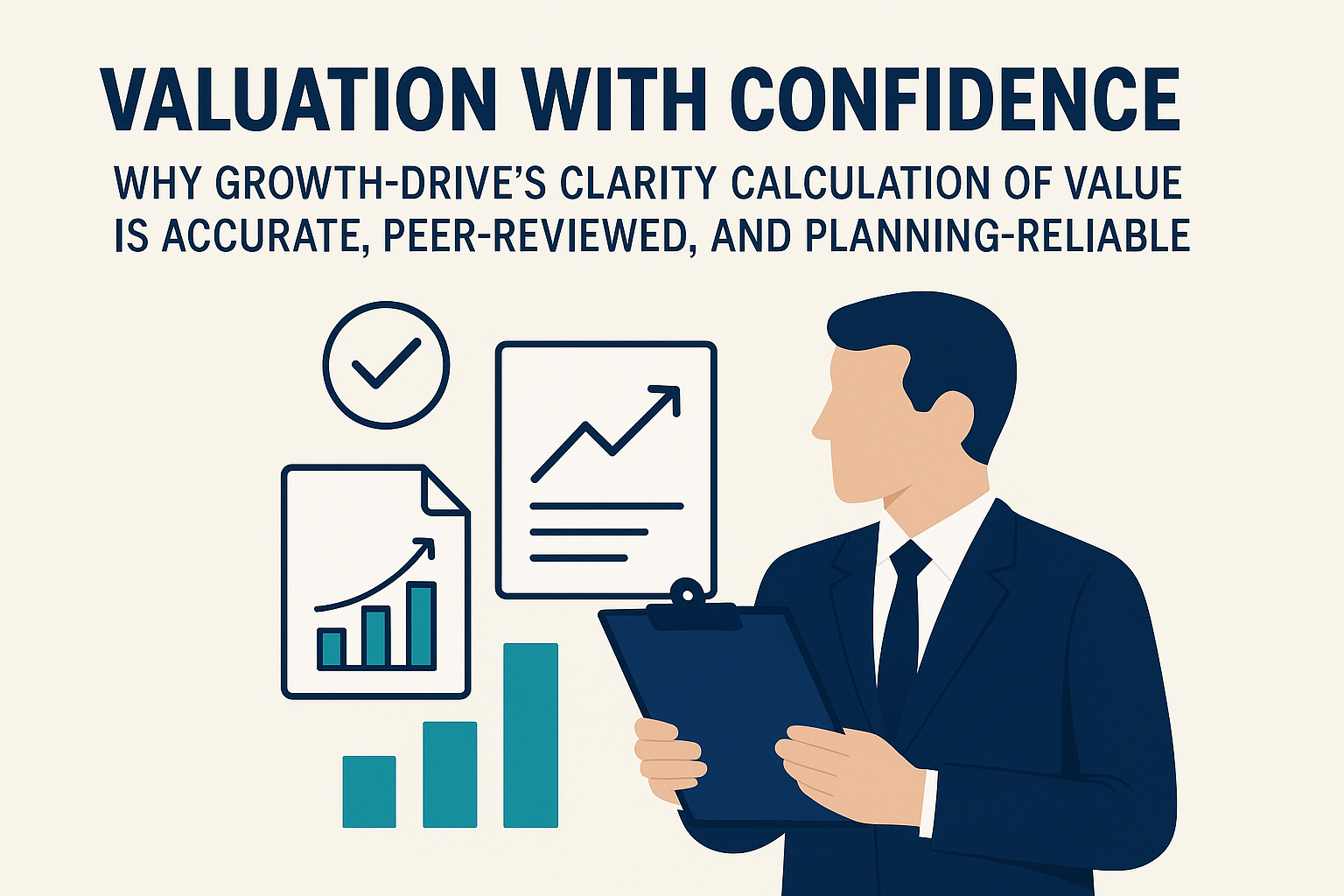Valuation + Confidence
Valuation With Confidence: Why Growth-Drive’s CLARITY Calculation of Value Is Accurate, Peer-Reviewed, and Planning-Reliable By George Sandmann,...
In a Growth-Drive ‘Business Advisor Mastermind Group’ meeting this week we got on the topic of succession planning. This prompted me to write this article which you can use in your client-facing marketing and deliverables.
Best-in-Class Businesses Use This Tool to Protect Cash and Transferable Value
Who should read this article? Business owners and CEOs of privately-held businesses with $2MM or more of annual revenue. Is this you?

Background: One of the key growth-driving objectives for creating predictable profits, growth and maximized transferable value is a plan-within-a-plan: your strategic plan should describe the orderly transfer of accountabilities in the case of short and long-term leadership absence. This is called succession planning, and having a succession plan is the hallmark of a best-in-class business because it protects cash and actually increases business value. Why? Because the market hates risk, and this plan mitigates existential risks to the business asset.
There are two types of succession plan, one where you are planning for the succession of your business to others, and the other describes a plan to replace senior leaders in the event they cannot perform their duties for a prolonged period.
We will look at ownership succession in our next article. Make sure you get it by subscribing.
Five things to consider when planning succession for your senior leadership team:
There are different considerations for short and long-term absences. Here is some guidance for tackling this issue - what should you do?
CEO: Document key CEO accountabilities; create decision-making protocols; empower the senior leadership team to meet these accountabilities in line with the protocols; conduct regular simulations to test and improve effectiveness. [Author’s note: this is how to cure owner dependence.]
Senior Leadership Team: Identify covered members; document accountabilities; identify internal and external succession candidates by role and accountability; prepare written knowledge transfer and onboarding protocols; communicate the resulting plans with key stakeholders; plan funding for succession.1
5. What are the steps you should take?Internal candidates:
External candidates:
6. How will you fund the succession plan?
This is an especially relevant question for replacing the CEO, and applies to temporary (for example hiring a Factional CEO) and permanent absences. Can the business afford to pay your compensation as well as that for your replacement? Funding is also an important consideration for permanently replacing a Senior Leader. The funding portion of the plan should account for signing bonuses to attract talent and to offset lost compensation/equity from prior employment. Additional expenses include relocation and the negative impact on your business from the succession-triggering event. There are three typical options to fund a succession plan:
Additional considerations: the succession plan might also address retaining current employees. Imagine that you as CEO unexpectedly leave the business due to disability or death. Will this cause uncertainty leading senior leaders and key employees to feel they have no other choice than to protect their families by seeking stable employment somewhere else? Insurance proceeds can be applied both to succession and to retention.
Recap, three key takeaways:
Having a succession plan protects cash, insulates the business from unforeseen events and increases business value.
[1]: CEO and Senior Leadership continuity courtesy Growth-Drive ‘Execute’ guidance for building a best-in-class business. ©2024 Growth-Drive.
To each of you: email blog@growth-drive.com to get a copy of this article you can use your marketing collateral (printed or digital).
Free (no card, free forever) CLARITY Strategic Capacity Analysis Lead Generator module.
Thank you, together we are executing towards our vision of helping $1 Trillion of privately held businesses increase strategic capacity in the three dimensions of business growth™. -George
Additional Resources:
Every member of our community can help with strategy and questions like continuity. See for example Growth-Drivers Jeff Ketchum, expert at building effective senior leadership teams; Patricia Malone PhD who is a strategy and execution guru; exit planning thought leader Michael Desiato CPA; public company senior leader-turned Business Advisor Tim Martin; Growth Advisor Larry Prince of Prince Leadership and more.
See also: BEI's (Business Enterprise Institute) excellent Owner-Based Planning program.

Valuation With Confidence: Why Growth-Drive’s CLARITY Calculation of Value Is Accurate, Peer-Reviewed, and Planning-Reliable By George Sandmann,...

When Tip, a seasoned business advisor, walked into an eight-hour strategy meeting with his client’s senior leadership team, he wasn’t sure what to...